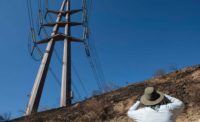Southern California Edison equipment may have sparked the blazing Silverado Fire near Irvine, Calif., the utility said in an Oct. 26 report to the California Public Utilities Commission.
The report says some of the utility’s overhead electrical facilities are located in the Silverado Fire’s origin area. “However, it appears that a lashing wire that was attached to an underbuilt telecommunication line may have contacted SCE’s overhead primary conductor which may have resulted in the ignition of the fire,” the report says.
“We reported the incident despite seeing no activity on the nearby 12-kV circuit nor any downed power lines because it appears that a lashing wire attached to a telecommunications line may have contacted SCE’s power line above it, possibly starting the fire,” says Chris Abel, spokesperson for SCE, which serves about 15 million people in a 50,000-sq-mile area across central, coastal and southern California.
With more than 1,800 firefighters on the fire line, the Silverado Fire, located in west Orange County, Calif., burned 12,600 acres and is 5% contained, according to CalFire. Meanwhile, the Blue Ridge fire, northeast of the Silverado Fire in Orange County, has burned 15,200 acres and is 0% percent contained. The fires, both of which started the morning of Oct. 26, forced over 90,000 residents to evacuate under mandatory orders. Ten houses were damaged, and Orange County Fire Authority is investigating the fire and reports of further damage.
SCE is required to submit a report to the CPUC on certain types of incidents, including those that receive significant media attention – like a wildfire – which may involve utility facilities, says Abel. “The submission of this report to the CPUC is intended to put the CPUC on notice of an incident so that it can conduct its own investigation.”
The CPUC is conducting a staff investigation to assess the compliance of electric facilities with applicable rules and regulations, says Terrie Prosper, CPUC spokesperson, who notes that CalFire or local fire districts determine the ignition source and the spread.
“It is up to each utility to determine whether to call a PSPS event, which must be the last resort to protect safety,” Prosper says.
At the same time, SCE cut power to over 18,000 customers through a Public Safety Power Shutoff, a mitigation effort that temporarily shuts off power to prevent electric systems from becoming an ignition source when fire risk is high. Southern California’s high wind and dry air prompted CalFire to issue red flag warnings, issued for weather which may result in extreme fire behavior.
Last February, Southern California Edison filed its 2020-22 wildfire mitigation plan with the California Public Utilities Commission (CPUC), a $3.8-billion multiyear effort that aims to reduce risk of fire ignitions caused by utility infrastructure.






Post a comment to this article
Report Abusive Comment